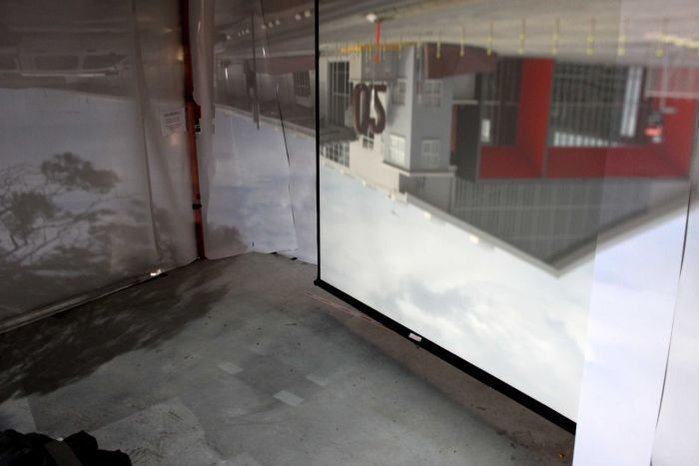Camera Obscura Project
September 1, 2014The first two weeks of July were spent constructing a Camera Obscura in a temporarily, unoccupied space in the Tasmanian College of the Arts. The space was on the corner of the building, had an interesting and colourful scene outside, along with the potential for frequent vehicular activity, which would provide humour in the inside image, as the cars would travel around the room upside down.
I had gained the necessary permissions and Gerrard Dixon, who is the Technical Officer in the Photography Department and I had done quite a lot of preparation, in that we had sourced black curtains and paper for the blackout and also white paper for the ‘screens’.
We had also already measured up the windows and main areas to be blacked out and we had a small sheet of aluminium to be drilled for the pinhole. We cut the paper on the long work tables in the Photography Department and then carried it all down to the vacant space, which was on the ground floor.
The room was blacked out over two or three days after it was cleaned thoroughly; the windows, surfaces and floor. The blackout process needed two of us, Gerrard on the ladder and me below, handing him things and being the ‘gofer’. We used black, photographic backdrop off cuts for the windows and on top of that we hung white, photographic backdrops as the screens on two sides of the room. The third wall was painted a light colour so we left that one as it was.
Multiple light leaks required remedial attention and some small ones we were not able to fully seal, particularly some in the high roof because of the nature of the old building. These were minor we decided and while in a perfect world we would have a totally light sealed space, we decided we could live with the ones we were unable to prevent, as they did not in the end affect the clarity of the image.
We experimented with several different aperture sizes and in the end we reached a compromise between light and sharpness of the image. The smaller the aperture the sharper the image but the less light there is in the space. The image is projected onto three walls of the space and because light travels in straight lines, the outside scene is projected onto the walls upside down as a moving image in real time.
We printed some signage, a description and also, for added interest, a vintage photograph owned by the Photography Department of a Camera Obscura, which was operating on the Hobart waterfront in the early days of the colony.
The Camera Obscura complements my Honours project as it expands the size of a pinhole camera to a scale that is larger than life. This enables visitors to walk right inside the inner workers of a camera, to witness a natural wonder, to understand how cameras function and how photography began.
